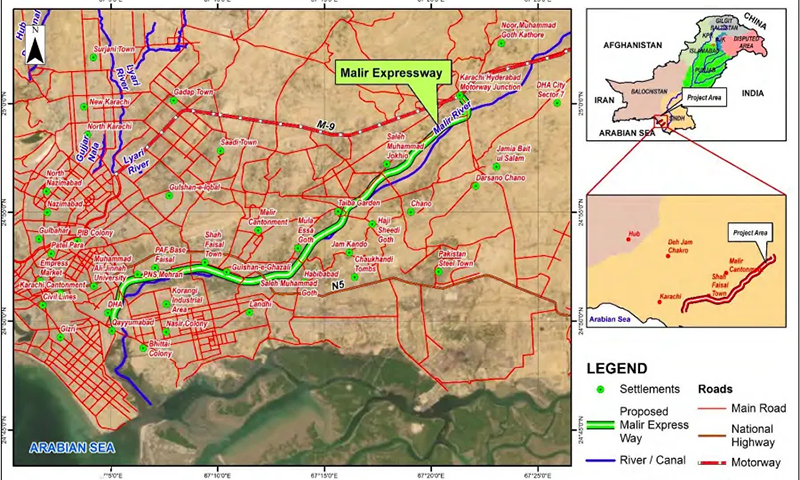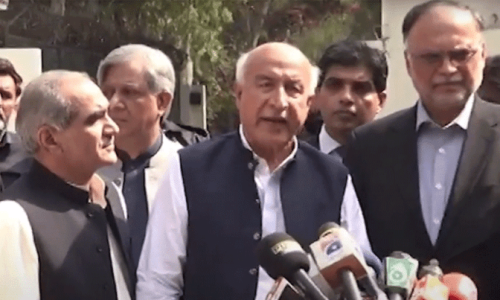KARACHI: Describing the Malir Expressway project as an attack on Karachi’s ecological heartland, representatives of local communities and environmental activists on Friday demanded that the project route be changed immediately as its current development on the right bank of the Malir river would have far-reaching implications on the whole city already experiencing 1.5-degree Celsius increase in its temperature.
The speakers also questioned the provincial government’s performance in the city and said the ruling Pakistan Peoples Party (PPP) “considered Karachi as a mere colony, especially its political stronghold such as Malir district, which had been handed over to drug, land and raiti-bajri mafias and to tyrannical officers such as Rao Anwar”.
They expressed these views while speaking at a press conference at the Karachi Press Club. The event was organised by citizens directly being affected by the project and environmental activists.
Sharing concerns over the project, Master Muhammad Aslam representing the Anti-Malir Expressway Action Committee said it was being built at the expense of city’s environment and the homes and crops of people already mired in hunger and poverty so that the elite of an impoverished city like Karachi could have more facilities.
Change of project’s route demanded
“The project is solely being built to benefit the builder mafia by increasing the property value of the projects recently developed by them on Malir’s agricultural lands,” he said.
The concerns pertaining to the expressway, he pointed out, should be taken seriously by all segments of society that considered Karachi their home.
“We must understand what we would lose, if we allow this project to materialise. It’s not just the locals who would lose their ancestral agricultural land and homes, the whole Karachi would suffer,” he warned.
The project site, he told journalists, was Karachi’s asset as it’s one of the last remaining green belts on city’s suburbs that had been playing a crucial role in mitigating the impact of climate change.
“The green belts in Gadap and Kathore have already been occupied to establish high-end residential societies and now Malir’s green belt is being ruthlessly squandered to put $160 million worth of public taxes into the pockets of the construction mafia,” he regretted.
On the losses local communities would suffer, Mr Aslam said it’s estimated that the project would destroy residence of more than 1,500 people, 210 permanent housing units, and 66.35 acres of privately-owned agriculture land and 49 acres of built-up area.
”In addition, many historical, religious and ancient structures would also be affected due to this project. These concerns have been raised multiple times by local residents, the media and experts and have also led to demonstrations by communities residing in and around the project site. But, nothing happened.”
The speakers also pointed to the potential urban flooding risk as the project was being developed on the Malir riverbed.
Questions over Sepa’s role
A major reservation highlighted several times during the event was allegedly unlawful actions of the Sindh Environmental Protection Agency (Sepa) adopted for project’s approval one of which was to make project’s environmental impact assessment (EIA) report public and approve it a year after the project was launched in clear violation of the provincial environmental law.
These concerns, it was said, were neither made part of the EIA report of the project nor discussed with stakeholders.
The other violation Sepa allegedly committed, the speakers said, was not to respond to reservations of the stakeholders including urban planners, who had submitted a detailed document to the environmental watchdog when it held a public hearing on project’s EIA report on March 9, this year.
The document contained relevant data as well as the potential impact of the Malir Expressway on the city’s environment and the local community.
They said the EIA report was bogus as it didn’t fully assess the damage the project would cause to Karachi’s ecology and the personal, social and economic costs that the area’s residents would incur.
“Unfortunately, the Sindh government ignored the serious concerns raised by Malir’s residents, their representatives and city’s urban planners, only to benefit the powerful owners of these construction projects as well as the government’s ministers and advisers,” said Hafeez Baloch of the Indigenous Rights Alliance.
‘Flaws’ in EIA report
The environmental watchdog, the speakers said, had become an institution to justify “mafia” schemes and to spoil the environment of Sindh instead of protecting it.
The EIA report, according to the speakers, justified the usage of land for the development of the expressway on the ground that it had limited water resources.
However, they claimed, the project would be destroying at least 27 wells that provided water to Malir’s agricultural land. This would also have an impact on the flow of water from smaller rivers falling into the Malir river, increasing city’s vulnerability to urban flooding.
This construction, they said, would not only exacerbate the water supply issue for the whole city but also increase the cost of agricultural produce.
According to the data shared in the presser, the EIA report didn’t not show that the project site rich in biodiversity. More than 176 birds have been identified only around the Malir dam, many of which are on the verge of extinction now.
“Furthermore, the project will disrupt the movement of wildlife on at least 39-kilometre-long path. The project says that local wildlife in the area is under threat but there is no discussion on the causes, which include projects such as Malir Expressway, DHA City and Education City,” Ahmed Shabbar of the Pakistan Maholiayati Tahafuz Movement said.
The EIA report, the speakers said, hinted at preparing a land acquisition and resettlement plan but people had no hopes that they would be properly resettled and rehabilitated considering the plight of citizens who have been displaced by other developments in the city and are still homeless.
Rights of the displaced
“The court had decided to relocate the victims of Karachi Circular Railway, Orangi and Gujjar nullahs to a place where all modern necessities of life including employment, health and transport facilities are available and the victims can live a dignified life.
“But to this day, government officials, who themselves live in posh localities, have forced the people to live in rubble, where women and children are forced to sleep and live under the open sky,” complained Zahid Farooq of the Urban Resource Centre.
The victims of the KCR, he said, had been kept like animals while many of the victims of the anti-encroachment drives at the Orangi and Gujjar nullahs were yet to have their registration done or receive their first cheques.
“It was decided to provide an alternate place within a period of two years, but even after the passage of a year and a half, a location has not been finalised. In the end, due to public pressure, they will be forced out of the city like it happened with the affectees of the Lyari Expressway,” he said.
Dr Nausheen Awar of the Karachi Urban Lab at the Institute of Business Administration said data of six decades showed that the city of Karachi had turned 1.5°C warmer now and facing multiple environmental challenges.
“Increase in temperature, the urban heat island effect, growing water stress, concretisation and significant reduction in green spaces are all interlinked. It’s time that Karachi sustaining a huge population is taken seriously,” she said.
Published in Dawn, May 7th, 2022














































